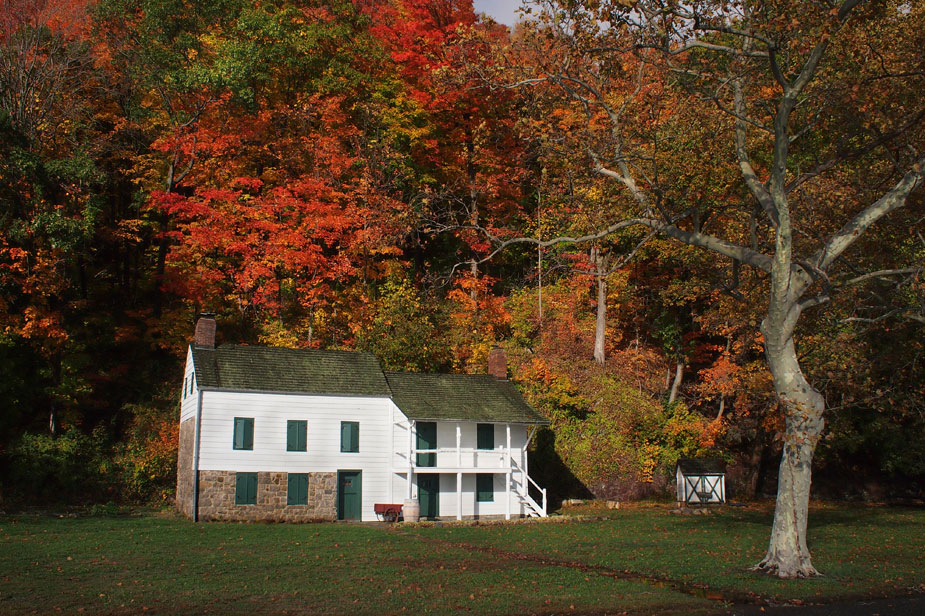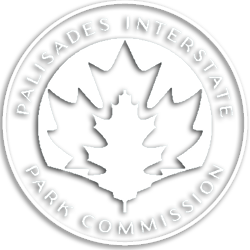GPS: 40.947412, -73.919027
The Kearney House is at the north end of Alpine Picnic Area . It is open to tour (no fee) on most* weekend & Holiday afternoons from May through October.
*In good weather, as long as staff is available, we open the Kearney House by 1 PM until around 4 PM, but on days of heavy or steady rain we generally do not open!
Office at Park Headquarters : 201-768-1360 ext. 6108.
Above: Leaders of the State Federation of Women’s Clubs visit the “Cornwallis Headquarters” in the early 1930s. Member clubs from across the state donated furnishings, quilts, and other artifacts to the house during this time. Below: A 1933 plaque honoring their efforts is still on display in the house’s “Park History Room.”
Photos: PIPC archives, Anthony Taranto.
Hurricane Sandy on October 29, 2012. Thanks to the efforts of many individuals and groups (and especially our amazing park maintenance crews!), the Kearney House reopened to the public on July 4, 2014.
Photos: Anthony Taranto, Jennette Zitelli Rowan.
The Kearney House is on Facebook!
At “Behind the Times at Mrs. Kearney’s Tavern,” summertime open-house events held at the Kearney House.
Photo: Anthony Taranto.
Sneaking a peak across time!
Photos: Anthony Taranto.
The Kearney House is listed on the National and New Jersey State Historic Registers as the “Blackledge-Kearney House,” and was once known as the “Cornwallis Headquarters” (it was thought the British General stayed here for a night in 1776).
Since 1909, the Palisades Interstate Park Commission has preserved this unique house with ongoing assistance from the New Jersey State Federation of Women’s Clubs .
The Kearney House c. 1897.
Photo courtesy of the Lamb family | PIPC archives.
The southern part of the house was built around 1761, the year the farmers of Closter built the “Closter Dock Road” from their farms, through a pass in the cliffs, and down to a dock – here! – on the Hudson River. From this dock they could ship goods to New York City’s markets by sailboat.
The house was most likely built to be a dockmaster’s house, to supervise the busy river landing.
In 1817, James and Rachel Kearney moved here with three children from her first husband, who died two years earlier. They had five children of their own before James died in 1831, and Rachel adopted a daughter besides – for a total of nine children she brought up here. The family also kept a tavern here, and “Auntie Kearney” was a well-known local figure until her death in 1870, at the age of ninety.
Mrs. Rachel (Slot–Powles) Kearney, date unknown.
Photo courtesty of Minnie D. Miles | PIPC archives.
The northern addition was probably built in the 1840s, during the Kearney House’s time as a tavern. Besides offering food and spirits, Mrs. Kearney’s tavern served as a meeting place for the captains, crews, and passengers of the vessels that arrived and departed daily from the docks here, and for the local workforce of quarrymen, dock workers, and tradesmen.
News, gossip, strongly argued political opinions, the latest joke – all would have been shared within these walls.
The upstairs room in the new addition may have been for lodgers staying at the tavern.
The Kearney House during the dedication of the Interstate Park, September 27, 1909 .
Photo: PIPC archives.
The Palisades Interstate Park Commission bought the house in 1907, and in 1909 had the big porch built as a grandstand for a dedication ceremony for the new park . Through the 1920s, the Commission used the house as a police station.
Park policemen in front of the Kearney House with officers from nearby World War I Camp Merritt .
Image courtesy of Lori Abry | PIPC archives.
Echoes of the past…
Kearney House interpreter (and temporary tavernkeep!) Eric Nelsen with tavern musician Thaddeus MacGregor and “Wee Jim” the limberjack at “Thanksgiving Time at Mrs. Kearney’s Tavern,” our annual end-of-season event.
Photo: Louise Savage.
Sign up for the park’s emailing list here:
We make every effort to ensure that the information on these pages is accurate and up-to-date, but policies and conditions in the park can change without notice or at the Superintendent’s discretion.
Links to pages outside the njpalisades.org domain are provided when we think such pages will be of interest to visitors to the Palisades Interstate Park in New Jersey, but we cannot verify the accuracy of information or be responsible for the quality of content they present.
Palisades Interstate Park in New Jersey
mail@njpalisades.org
Accident | Fire | Emergency
Copyright © 1998–2025
Palisades Interstate Park Commission
Phone: 845-786-2701
Home | Top of Page


